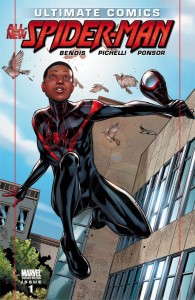Mara Wood is a school psychology doctoral student at the University of Central Arkansas. Her research focus is on the educational application of comics as well as their use in therapeutic settings with children and adolescents. She is a regular contributor for Talking Comics, a co-host on The Missfits podcast, and writes about psychology, comics, books, and Dungeons & Dragons on her personal blog. You can find her on twitter as @MegaMaraMon
Click here for the introduction to the Comics, Human Rights and Representation Week.

Media dictates what we know about other people. No matter how you slice it, our exposure to television, books, and movies informs what we perceive. The majority of media features stories about White males. Representation of ethnic, racial, sexual and other minorities is low, and flawed.
Social identity theory posits that the groups and categories we belong to provide the characteristics that define our self-concept (Mastro, 2003). The groups essentially provide us with the normative attitudes and beliefs required for social membership. Social development is an essential part of human growth and development, one that is needed for society. Media capitalizes on this theory with the way it presents characters from minority groups.
We all belong to a group. I am a White American woman living in South. I am also a fervent comic book fan. I identify with those two groups (even though sometimes they conflict). Others see themselves as members of a sports fandom, a racial group, or career. No matter what the group is, we tend to look for ways that we are similar with others in that group. Generally speaking, we seek out positive characteristics of our own group. In contrast, we note and emphasize negative characteristics of those in groups that our outside of our own. This is the in-group bias. We are prone to seeing our own group as superior to others, no matter how arbitrarily the group is formed. The in-group forms stereotypes about the out-group, and conflict arises. We use examples of out-group behavior that are most prominent to support the stereotype. Racism spawns from in-group favoritism. The more similar the groups, the greater the need to distinguish differences.
Not surprisingly, media subsequently aims to capitalize on these in-group and out-group distinctions.

Mastro (2003) describes how American television portrayals of Latinos emphasize criminal characteristics while promoting the justification of White actions. Propaganda during WWII focused on demonizing the Jews. This Nazi propaganda solidified the in-group bias of the German people. Today, we still see traces of this kind of biases. The portrayals may be subtle, but they still underrepresent minorities while promoting stereotypes. For many people with limited exposure to multicultural societies, the only exposure to particular minority groups may be through media portrayal.
Exposure to different types of people through the media opens the door for exploring identification. Identification is the process through which consumers experience reception and interpretation of the media from the inside (Cohen, 2001). Through identification, we picture ourselves as relating to the character in one way or another. We want to like them, are like them, and want to be like them. Consumers experience happiness when good things happen to characters, sadness when tragic things happen, and root for their success within a story. Fan fiction, more or less, has its roots in identification. From a psychological perspective, identification opens the door to using fictional characters as a means to explore cognitive beliefs held by the consumer.
Transportation in Comics
In 2013, my colleague Allen Thomas and I did a study using transportation and comic books. We wanted to tap into how people connect with characters. More importantly, we aimed to identify which characters the readers were drawn to.

Transportation is a relatively new concept in social psychology. Green and Brock (2000) explored transportation in their definitive study of persuasive narratives. Transportation is the process in which mental systems of attention, imagery, and feelings are focused on events in a narrative. Think of transportation like getting lost in a book: You lose track of time, things happening in the room become out of focus, and you are invested in the outcomes of the story. Transportation research has primarily focused on this phenomenon as it exists in television and video games. Our research studied how transportation functions in comic books with regards to the types of characters presented to the reader. By looking at patterns of transportation in the context of representation, we hoped to lay the foundation for research in bibliotherapy using comic books with diverse populations.
Our first study looked at the gender of the reader and the gender of the character. We predicted that men would have higher transportation scores with male characters, and women would have higher transportation scores with female characters. We were sufficiently surprised when we found that men and women had higher transportation scores with our female condition. This find was surprising for a number of reasons. First, everything we have heard about media suggests that the male condition should have elicited a higher degree of transportation. Most media features a white male character, making it the situation readers and viewers are most familiar with. Second, the idea of higher degrees of connectivity with a female-led story suggests that it is time to reconsider who we feature as main characters. Men and women alike can transport and engage with a story about a female character, and this finding has the potential to open the doors for more representation in the media.
Our second study in 2014 also involved transportation in comics. With the findings from the previous study, we decided to expand our conditions to include black character conditions. We looked at the gender and race of the reader as well as the gender and race of the character. Again, we predicted transportation scores to be highest with characters that represented the characteristics of the reader. We found that all readers had a higher degree of transportation with non-White characters, and men still had a higher transportation with female characters overall. Though these results were not statistically significant, they provide insight into the need for more research on diversity and representation in comics.
What does this all mean for representation in comics? Well, for starters, there is no statistical reason for not having minorities and women as lead characters in books.

I predict with more data looking at transportation and identification, psychologists can show that readers will accept diverse characters as much as they have white male characters. A lot of this also depends on the content of the story; there is a degree of self-fulfilling prophecy when it comes to stories featuring non-white male characters, especially in the realm of superheroes. Believing that a book starring minority characters will fail leads to less promotion of the book and less creative investment. On the flipside, excitement and fervour over a book starring diverse characters, like Saga and Ms. Marvel, will increase sales and readership.
By increasing representation in comic books, creators can help increase identification with certain subsets of readers while also combating stereotypes. With conscious effort, in-group bias can be ignored in favour of out-group representation. Even better, diversity of creators can share their worldviews through the characters they write. More representation can increase comics readership and expose readers to perspectives that they had not previously experienced.
Today, take a moment to check out a comic book you never picked up. You may be surprised at how you feel towards the character and the story.
Click here to read all of the Comics, Human Rights and Representation articles.

